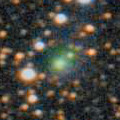
|
Now it is bright as 9.9 mag (Apr. 19, Juan Jose Gonzalez). It is expected to brighten up to 9 mag in summer. In the Southern Hemisphere, it stays observable in good condition for a long time until the comet will fade out. In the Northern Hemisphere, it is observable only until June.
Date(TT) R.A. (2000) Decl. Delta r Elong. m1 Best Time(A, h)
Apr. 28 19 42.30 -8 28.1 2.113 2.511 101 10.6 3:40 (327, 41)
May 5 19 41.17 -10 43.1 1.961 2.475 108 10.4 3:31 (333, 41)
|
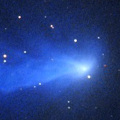
|
Now it is 11.5 mag (Apr. 18, Juan Jose Gonzalez). It stays bright as 11 mag for a long time. In the Southern Hemisphere, it is not observable for a long time after this. In the Northern Hemispehre, it stays observable for a long time until the comet fades out. But it will be getting lower gradually after this.
Date(TT) R.A. (2000) Decl. Delta r Elong. m1 Best Time(A, h)
Apr. 28 5 9.85 42 52.4 3.195 2.605 46 11.0 20:15 (125, 28)
May 5 5 22.81 44 11.1 3.245 2.603 43 11.0 20:23 (128, 25)
|
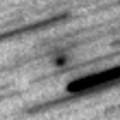
|
It brightened rapidly as expected. Now it is very bright as 10.8 mag (Apr. 20, Katsumi Yoshimoto). It stays at 11-12 mag until June. In the Southern Hemisphere, it stays observable in excellent condition. In the Northern Hemisphere, it will be unobservable from April to June when the comet becomes brightest.
Date(TT) R.A. (2000) Decl. Delta r Elong. m1 Best Time(A, h)
Apr. 28 21 26.75 -39 26.9 0.919 1.321 86 12.1 3:40 (323, 2)
May 5 22 3.17 -38 20.5 0.905 1.304 85 11.9 3:31 (320, 1)
|
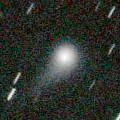
|
Now it is 12.1 mag (Apr. 18, Juan Jose Gonzalez). It stays 12 mag for a long time until spring in 2019. In the Northern Hemisphere, it stays observable in good condition for a long time, although it becomes unobservable temporarily from mid June to August. In the Southern Hemisphere, it is not observable until September.
Date(TT) R.A. (2000) Decl. Delta r Elong. m1 Best Time(A, h)
Apr. 28 7 48.77 60 29.7 2.907 2.802 73 12.1 20:15 (146, 53)
May 5 7 47.88 57 11.4 2.986 2.780 68 12.1 20:23 (139, 49)
|

|
The condition of this apparition is worst. It brightens up to 12.5 mag from April to May. But it is not observable at all.
Date(TT) R.A. (2000) Decl. Delta r Elong. m1 Best Time(A, h)
Apr. 28 2 11.51 10 45.7 1.605 0.604 3 12.5 3:40 (242,-19)
May 5 2 57.53 13 19.2 1.615 0.613 3 12.6 20:23 (122,-18)
|
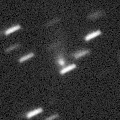
|
Now it is 15.1 mag (Mar. 22, Alexander Baransky). It will brighten up to 9 mag in summer. However, it is hardly observable when it is bright. In the Northern Hemisphere, it is not observable until late December. In the Southern Hemisphere, it is observable from July to September, but it locates in extremely low.
Date(TT) R.A. (2000) Decl. Delta r Elong. m1 Best Time(A, h)
Apr. 28 2 28.86 29 56.7 2.593 1.650 16 13.2 20:15 (133, -5)
May 5 2 44.08 28 25.2 2.526 1.556 12 12.9 3:31 (226, -8)
|
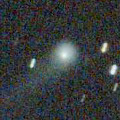
|
Now it is very bright as 12.3 mag (Apr. 18, Juan Jose Gonzalez). It will be observable at 12-13 mag for a long time from 2017 to 2018. In the Southern Hemisphere, it will be hardly observable after this.
Date(TT) R.A. (2000) Decl. Delta r Elong. m1 Best Time(A, h)
Apr. 28 14 8.20 56 44.7 3.325 3.778 109 13.0 23:40 (180, 68)
May 5 13 43.87 56 58.5 3.389 3.789 105 13.0 22:49 (180, 68)
|

|
Appearing in the morning sky. Now it is a bit brighter, 15.4 mag (Apr. 25, Jean-Francois Soulier).
Date(TT) R.A. (2000) Decl. Delta r Elong. m1 Best Time(A, h)
Apr. 28 22 59.40 -2 34.0 6.343 5.785 52 13.7 3:40 (281, 11)
May 5 23 3.24 -2 2.1 6.253 5.784 58 13.7 3:31 (283, 15)
|
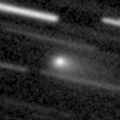
|
Now it is bright as 12.6 mag (Apr. 16, Chris Wyatt). It will be observable at 13-14 mag in good condition from spring to summer.
Date(TT) R.A. (2000) Decl. Delta r Elong. m1 Best Time(A, h)
Apr. 28 21 33.34 -20 12.9 1.478 1.611 78 14.0 3:40 (309, 16)
May 5 21 50.88 -18 17.4 1.432 1.610 80 13.9 3:31 (308, 17)
|
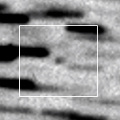
|
Now it is 16.3 mag (Apr. 20, Toshihiko Ikemura, Hirohisa Sato). It will brighten rapidly after this, and it will brighten up to 11 mag from summer to autumn. It is observable in excellent condition in the Southern Hemisphere. It locates somewhat low in the Northern Hemisphere.
Date(TT) R.A. (2000) Decl. Delta r Elong. m1 Best Time(A, h)
Apr. 28 20 58.85 -15 53.8 2.015 2.169 84 14.3 3:40 (313, 24)
May 5 21 10.99 -15 35.3 1.921 2.150 88 14.0 3:31 (314, 25)
|

|
It brightened up to 7.1 mag from May to June in 2017 (June 21, Juan Jose Gonzalez). Now it is fading. It has already faded down to 15.2 mag (Mar. 4, B. Lutkenhoner). In the Southern Hemisphere, it stays observable for a long time after this. It will never be observable again in the Northern Hemisphere.
Date(TT) R.A. (2000) Decl. Delta r Elong. m1 Best Time(A, h)
Apr. 28 0 54.22 -43 9.6 4.529 4.127 60 14.8 3:40 (303,-32)
May 5 1 3.45 -43 0.9 4.540 4.192 63 14.9 3:31 (304,-30)
|
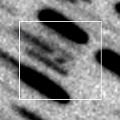
|
Now it is 16.4 mag (Apr. 22, Toshihiko Ikemura, Hirohisa Sato). It will brighten rapidly, and brighten up to 7 mag from August to September. In the Northern Hemisphere, it will be observable in excellent condition. In the Southern Hemisphere, it will be unobservable from July to August. But it will be observable in good condition before and after tha.
Date(TT) R.A. (2000) Decl. Delta r Elong. m1 Best Time(A, h)
Apr. 28 19 37.00 17 21.0 1.624 1.996 95 15.3 3:40 (304, 63)
May 5 19 47.55 20 14.0 1.517 1.932 97 14.9 3:31 (302, 66)
|
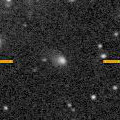
|
Now it is 15.0 mag (Apr. 19, Toshihiko Ikemura, Hirohisa Sato). It is expected to brighten up to 13-14 mag from 2018 to 2019. In the Northern Hemisphere, it stays observable in good condition for a long time. In the Southern Hemisphere, it locates extremely low until summer.
Date(TT) R.A. (2000) Decl. Delta r Elong. m1 Best Time(A, h)
Apr. 28 19 26.45 44 27.9 3.971 4.088 89 15.1 3:40 (233, 71)
May 5 19 19.71 45 10.6 3.868 4.051 93 15.0 3:31 (223, 75)
|

|
Now it is 16.2 mag (Mar. 17, S. G. McAndrew). It stays 15 mag from 2018 to 2019, and it will be observable for a long time in the Southern Hemisphere. In the Northern Hemisphere, it will never be observable again.
Date(TT) R.A. (2000) Decl. Delta r Elong. m1 Best Time(A, h)
Apr. 28 12 57.59 -67 57.3 3.955 4.599 124 15.3 22:31 ( 0,-13)
May 5 12 44.87 -68 5.4 3.922 4.569 124 15.3 21:51 ( 0,-13)
|
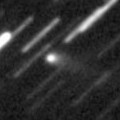
|
It brightened up to 12.7 mag in winter (Jan. 6, Thomas Lehmann). Now it is fading. It has already faded down to 15.0 mag (Mar. 22, Toshihiko Ikemura, Hirohisa Sato). It will be unobservable soon.
Date(TT) R.A. (2000) Decl. Delta r Elong. m1 Best Time(A, h)
Apr. 28 4 31.28 17 34.1 3.225 2.426 31 15.4 20:15 (106, 9)
May 5 4 42.54 19 26.7 3.321 2.473 27 15.6 20:23 (111, 5)
|
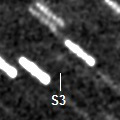
|
It is expected to approach to Sun down to 0.2 a.u. and brighten up to 3 mag in August. Now it is 16.6 mag (Apr. 22, Thomas Lehmann). In the Northern Hemisphere, it stays observable in the morning sky until early August when the comet brightens up to 6 mag. It is not observable at all in the Southern Hemisphere.
Date(TT) R.A. (2000) Decl. Delta r Elong. m1 Best Time(A, h)
Apr. 28 23 45.75 54 5.6 2.848 2.335 50 16.0 3:40 (222, 30)
May 5 0 1.36 54 43.4 2.737 2.228 50 15.7 3:31 (222, 31)
|

|
Appearing in the morning sky. It is observable at 15 mag in 2018, in good condition in the Southern Hemisphere. It locates somewhat low in the Northern Hemisphere.
Date(TT) R.A. (2000) Decl. Delta r Elong. m1 Best Time(A, h)
Apr. 28 22 36.07 -17 29.6 3.375 3.063 63 15.8 3:40 (297, 7)
May 5 22 44.41 -16 57.9 3.300 3.074 68 15.8 3:31 (298, 9)
|
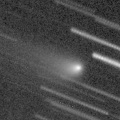
|
Appearing in the morning sky. It is fading now. But it stays 16 mag until summer. But actually, it is 18.1 mag (Mar. 23, Toshihiko Ikemura, Hirohisa Sato), fainter than this ephemeris.
Date(TT) R.A. (2000) Decl. Delta r Elong. m1 Best Time(A, h)
Apr. 28 18 42.35 -25 50.7 3.086 3.666 117 15.9 3:40 (350, 28)
May 5 18 30.35 -26 28.5 3.012 3.711 127 15.9 3:31 (357, 29)
|

|
It brightens up to 16 mag in spring. In the Southern Hemisphere, it stays observable until August, but it will be unobservable after that. In the Northern Hemisphere, it stays unobservable until June, but it will be observable in good condition after that. Its cometary activity was observed on Mar. 26 (M. Mommert, D. Polishook, N. Moskovitz).
Date(TT) R.A. (2000) Decl. Delta r Elong. m1 Best Time(A, h)
Apr. 28 23 40.16 -23 25.7 1.532 1.246 54 16.0 3:40 (293, -9)
May 5 0 0.14 -19 13.0 1.524 1.240 54 16.0 3:31 (289, -7)
|
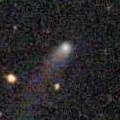
|
Now it is 16.1 mag (Apr. 15, Toshihiko Ikemura, Hirohisa Sato). It stays 16 mag for a long time from 2017 to 2018. It is observable in excellent condition in the Northern Hemisphere. It locates very low in the Southern Hemisphere.
Date(TT) R.A. (2000) Decl. Delta r Elong. m1 Best Time(A, h)
Apr. 28 7 5.47 44 48.9 5.767 5.452 66 16.1 20:15 (120, 49)
May 5 7 6.28 44 57.9 5.881 5.464 60 16.1 20:23 (122, 43)
|
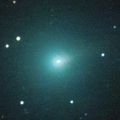
|
It brightened up to 9.2 mag from November to December (Nov. 16, Juan Jose Gonzalez). Now it is fading rapidly. It has already faded down to 16.6 mag (Apr. 12, Toshihiko Ikemura, Hirohisa Sato). It stays observable in good condition until summer when it fades out.
Date(TT) R.A. (2000) Decl. Delta r Elong. m1 Best Time(A, h)
Apr. 28 13 47.42 5 25.1 1.211 2.180 158 16.1 23:21 ( 0, 60)
May 5 13 41.59 5 4.4 1.281 2.229 153 16.5 22:48 ( 0, 60)
|
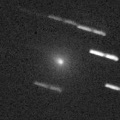
|
It brightened up to 11 mag in February. Now it is fading. It has already faded down to 14.5 mag (Apr. 5, Martin Masek). It stays observable in the evening sky until the comet fades out.
Date(TT) R.A. (2000) Decl. Delta r Elong. m1 Best Time(A, h)
Apr. 28 6 5.00 12 2.3 1.895 1.548 54 16.1 20:15 ( 88, 25)
May 5 6 27.38 12 1.3 1.998 1.615 53 16.7 20:23 ( 90, 22)
|

|
Now it is 16.0 mag (Apr. 6, Sandor Szabo). It will be fading slowly until summer.
Date(TT) R.A. (2000) Decl. Delta r Elong. m1 Best Time(A, h)
Apr. 28 11 20.68 13 6.0 2.842 3.551 127 16.2 20:55 ( 0, 68)
May 5 11 20.05 12 53.1 2.925 3.553 121 16.2 20:27 ( 0, 68)
|
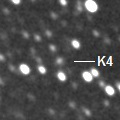
|
It was observed at 16 mag from summer to autumn in 2017. It will be observable at 16.5 mag in good condition also in 2018. It locates somewhat low in the Southern Hemisphere.
Date(TT) R.A. (2000) Decl. Delta r Elong. m1 Best Time(A, h)
Apr. 28 23 39.34 8 31.5 3.567 2.867 39 16.3 3:40 (266, 10)
May 5 23 49.11 10 5.9 3.538 2.894 43 16.4 3:31 (266, 12)
|
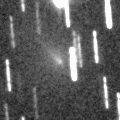
|
It brightened up to 15-16 mag in winter. Appearing in the morning sky. It stays observable at 16.5 mag for a while. It will be observable in good condition after this in the Southern Hemisphere. But it stays low in the Northern Hemisphere.
Date(TT) R.A. (2000) Decl. Delta r Elong. m1 Best Time(A, h)
Apr. 28 22 55.55 -4 45.6 2.137 1.749 54 16.6 3:40 (284, 11)
May 5 22 52.42 -6 35.8 2.025 1.795 62 16.6 3:31 (288, 14)
|

|
Now it is 16.6 mag (Apr. 9, Toshihiko Ikemura, Hirohisa Sato). It will be fading slowly after this.
Date(TT) R.A. (2000) Decl. Delta r Elong. m1 Best Time(A, h)
Apr. 28 10 17.34 8 49.2 9.164 9.642 115 16.6 20:15 ( 12, 63)
May 5 10 17.64 8 59.1 9.275 9.647 108 16.7 20:23 ( 30, 61)
|

|
Now it is 16.7 mag (Apr. 15, Toshihiko Ikemura, Hirohisa Sato). It will brighten up to 15 mag in January, 2019. It stays observable in excellent condition in the Northern Hemispehre. It is observable only until June in the Southern Hemisphere.
Date(TT) R.A. (2000) Decl. Delta r Elong. m1 Best Time(A, h)
Apr. 28 11 1.94 32 51.5 3.562 4.068 113 16.9 20:36 ( 0, 88)
May 5 10 53.57 33 32.7 3.644 4.032 105 16.9 20:23 ( 73, 85)
|
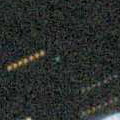
|
First return of a new periodic comet which brightened up to 13 mag in 2013. Now it is 17.8 mag (Apr. 19, Katsumi Yoshimoto). It will brighten very rapidly after this, up to 11 mag in summer. In the Southern Hemisphere, it stays observable in good condition all through this apparition. In the Northern Hemisphere, it is not observable at the high light from mid June to mid August.
Date(TT) R.A. (2000) Decl. Delta r Elong. m1 Best Time(A, h)
Apr. 28 8 35.43 33 32.4 0.722 1.191 85 17.7 20:15 ( 95, 64)
May 5 8 38.01 31 24.9 0.696 1.120 79 16.9 20:23 ( 95, 57)
|
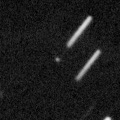
|
Now it is 16.3 mag (Apr. 15, Toshihiko Ikemura, Hirohisa Sato). It is observable at 17 mag from spring to summer.
Date(TT) R.A. (2000) Decl. Delta r Elong. m1 Best Time(A, h)
Apr. 28 15 4.62 40 12.8 1.251 2.004 124 17.0 0:43 (180, 85)
May 5 14 59.90 38 44.6 1.228 1.987 125 16.9 0:11 (180, 86)
|
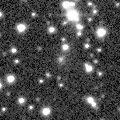
|
Now it is 16.0 mag (Apr. 6, Sandor Szabo). It is observable in good conditioin in the Northern Hemisphere. It is not observable for a long time in the Southern Hemisphere.
Date(TT) R.A. (2000) Decl. Delta r Elong. m1 Best Time(A, h)
Apr. 28 6 25.73 72 4.3 8.960 8.635 68 16.9 20:15 (159, 41)
May 5 6 35.16 71 44.5 9.009 8.627 64 17.0 20:23 (158, 39)
|
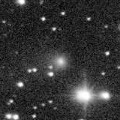
|
Now it is 16.4 mag (Mar. 14, Toshihiko Ikemura, Hirohisa Sato). It will be fading after this. In the Northern Hemisphere, it stays observable in the northern sky for a long time. It is not observable at all after this in the Southern Hemisphere.
Date(TT) R.A. (2000) Decl. Delta r Elong. m1 Best Time(A, h)
Apr. 28 6 4.38 86 19.7 3.987 3.833 73 17.0 20:15 (176, 37)
May 5 7 42.63 84 33.9 4.052 3.869 72 17.1 20:23 (174, 38)
|

|
Now it is 16.4 mag (Apr. 19, Toshihiko Ikemura, Hirohisa Sato). It will be fading gradually after this, and it will be fainter than 18 mag in autumn. In the Northern Hemisphere, it stays observable in good condition for a long time. In the Southern Hemisphere, it will never be observable again.
Date(TT) R.A. (2000) Decl. Delta r Elong. m1 Best Time(A, h)
Apr. 28 22 43.55 67 32.3 7.506 7.120 63 17.1 3:40 (208, 40)
May 5 22 52.69 68 18.3 7.532 7.143 63 17.1 3:31 (207, 40)
|
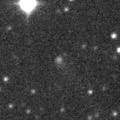
|
Now it is 16.6 mag (Apr. 21, Toshihiko Ikemura, Hirohisa Sato). It will be fainter than 18 mag in summer.
Date(TT) R.A. (2000) Decl. Delta r Elong. m1 Best Time(A, h)
Apr. 28 14 48.37 -11 11.7 5.360 6.359 172 17.2 0:27 ( 0, 44)
May 5 14 45.11 -10 15.3 5.373 6.377 174 17.2 23:52 ( 0, 45)
|
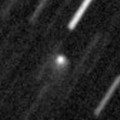
|
Now it is 18.0 mag (Apr. 19, Toshihiko Ikemura, Hirohisa Sato). It will be fading after this, and it will be fainter than 18 mag in July.
Date(TT) R.A. (2000) Decl. Delta r Elong. m1 Best Time(A, h)
Apr. 28 11 37.05 25 4.9 5.075 5.702 124 17.2 21:11 ( 0, 80)
May 5 11 32.63 25 43.3 5.201 5.728 116 17.3 20:40 ( 0, 81)
|
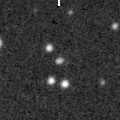
|
Now it is 16.3 mag (Apr. 20, Toshihiko Ikemura, Hirohisa Sato). It is observable at 17 mag in good condition in spring.
Date(TT) R.A. (2000) Decl. Delta r Elong. m1 Best Time(A, h)
Apr. 28 12 46.34 -10 26.6 1.577 2.533 156 17.2 22:21 ( 0, 45)
May 5 12 44.21 -9 53.2 1.611 2.532 149 17.4 21:51 ( 0, 45)
|

|
It has not been observed yet in this apparition. It will brighten rapidly, and it is expected to brighten up to 10 mag in autumn. It will be observable in excellent condition in the Northern Hemisphere. It stays low in the Southern Hemisphere.
Date(TT) R.A. (2000) Decl. Delta r Elong. m1 Best Time(A, h)
Apr. 28 21 48.77 -12 50.3 2.605 2.492 72 17.5 3:40 (301, 18)
May 5 21 59.09 -11 38.0 2.470 2.438 76 17.3 3:31 (302, 20)
|
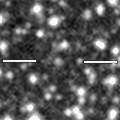
|
Now it is 17.9 mag (Apr. 21, Toshihiko Ikemura, Hirohisa Sato). It stays observable at 17 mag in good condition from spring to autumn.
Date(TT) R.A. (2000) Decl. Delta r Elong. m1 Best Time(A, h)
Apr. 28 20 53.17 -1 7.9 6.046 5.995 82 17.4 3:40 (303, 36)
May 5 20 55.82 -0 38.5 5.942 5.993 88 17.3 3:31 (306, 39)
|
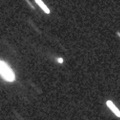
|
Now it is 16.9 mag (Apr. 12, Toshihiko Ikemura, Hirohisa Sato). It will be fading gradually after this.
Date(TT) R.A. (2000) Decl. Delta r Elong. m1 Best Time(A, h)
Apr. 28 10 42.94 37 30.5 7.921 8.281 107 17.5 20:18 (180, 88)
May 5 10 40.32 36 54.2 8.043 8.302 101 17.5 20:23 (106, 83)
|
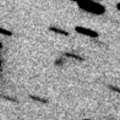
|
Now it is 17.7 mag (Mar. 25, D. Buczynski). It stays observable at 17-18 mag in good condition for a while.
Date(TT) R.A. (2000) Decl. Delta r Elong. m1 Best Time(A, h)
Apr. 28 14 59.95 -4 6.0 1.791 2.778 166 17.5 0:38 ( 0, 51)
May 5 14 54.03 -3 46.6 1.821 2.814 167 17.6 0:05 ( 0, 51)
|

|
Now it is 19.3 mag (Apr. 20, Toshihiko Ikemura, Hirohisa Sato). It was predicted to be observable at 17.5 mag in good condition from spring to summer. But recently, it is fainter than predicted.
Date(TT) R.A. (2000) Decl. Delta r Elong. m1 Best Time(A, h)
Apr. 28 16 32.56 -8 8.0 2.998 3.882 147 17.7 2:11 ( 0, 47)
May 5 16 29.37 -7 59.3 2.951 3.881 153 17.6 1:40 ( 0, 47)
|
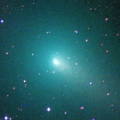
|
It brightened up to 8-9 mag in autumn. Now it is fading rapidly. It has already faded down to 18.3 mag (Apr. 15, Toshihiko Ikemura, Hirohisa Sato). In the Northern Hemisphere, it stays observable in good condition for a long time. In the Southern Hemisphere, it will never be observable again after this.
Date(TT) R.A. (2000) Decl. Delta r Elong. m1 Best Time(A, h)
Apr. 28 8 40.08 57 11.1 2.920 2.934 80 17.6 20:15 (147, 60)
May 5 8 51.97 55 12.8 3.056 3.004 77 17.9 20:23 (140, 58)
|
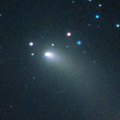
|
It brightened up to 9-10 mag from December to February. Now it is fading very rapidly. It has already faded, fainter than 18.5 mag (Apr. 17, Martin Masek). In the Northern Hemisphere, it stays extremely low after this. In the Southern Hemisphere, it will be getting higher in the morning sky after this, then it stays observable in good condition.
Date(TT) R.A. (2000) Decl. Delta r Elong. m1 Best Time(A, h)
Apr. 28 22 17.75 -30 42.5 1.340 1.428 73 17.7 3:40 (309, 1)
May 5 22 22.87 -36 36.3 1.318 1.537 81 18.0 3:31 (315, -1)
|
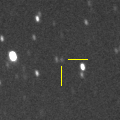
|
Now it is 17.9 mag (Mar. 16, ATLAS-HKO, Haleakala). It stays 18 mag from 2018 to 2020. It is observable in good condition in the Southern Hemisphere. It locates extremely low in the Northern Hemisphere.
Date(TT) R.A. (2000) Decl. Delta r Elong. m1 Best Time(A, h)
Apr. 28 12 27.50 -37 31.7 3.647 4.513 145 17.9 22:02 ( 0, 17)
May 5 12 23.58 -37 5.3 3.671 4.509 142 17.9 21:30 ( 0, 18)
|
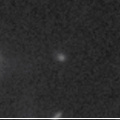
|
Now it is 16.6 mag (Apr. 19, Toshihiko Ikemura, Hirohisa Sato). It is observable at 18 mag in good condition in spring.
Date(TT) R.A. (2000) Decl. Delta r Elong. m1 Best Time(A, h)
Apr. 28 12 19.64 -0 9.0 1.278 2.193 147 17.9 21:54 ( 0, 55)
May 5 12 18.45 0 37.6 1.305 2.174 139 17.9 21:26 ( 0, 56)
|
|
![]()
 C/2017 T3 ( ATLAS )
C/2017 T3 ( ATLAS ) C/2015 O1 ( PanSTARRS )
C/2015 O1 ( PanSTARRS ) 29P/Schwassmann-Wachmann 1
29P/Schwassmann-Wachmann 1 37P/Forbes
37P/Forbes 48P/Johnson
48P/Johnson C/2015 V2 ( Johnson )
C/2015 V2 ( Johnson ) 21P/Giacobini-Zinner
21P/Giacobini-Zinner C/2017 M4 ( ATLAS )
C/2017 M4 ( ATLAS ) C/2017 B3 ( LINEAR )
C/2017 B3 ( LINEAR ) C/2017 K6 ( Jacques )
C/2017 K6 ( Jacques ) C/2017 S3 ( PanSTARRS )
C/2017 S3 ( PanSTARRS ) 65P/Gunn
65P/Gunn C/2015 VL62 ( Lemmon-Yeung-PanSTARRS )
C/2015 VL62 ( Lemmon-Yeung-PanSTARRS ) (3552) Don Quixote
(3552) Don Quixote C/2016 A1 ( PanSTARRS )
C/2016 A1 ( PanSTARRS ) 62P/Tsuchinshan 1
62P/Tsuchinshan 1 185P/Petriew
185P/Petriew 74P/Smirnova-Chernykh
74P/Smirnova-Chernykh C/2017 K4 ( ATLAS )
C/2017 K4 ( ATLAS ) C/2017 S6 ( Catalina )
C/2017 S6 ( Catalina ) C/2014 B1 ( Schwartz )
C/2014 B1 ( Schwartz ) C/2018 A3 ( ATLAS )
C/2018 A3 ( ATLAS ) 364P/2018 A2 ( PanSTARRS )
364P/2018 A2 ( PanSTARRS ) C/2018 C2 ( Lemmon )
C/2018 C2 ( Lemmon ) C/2010 U3 ( Boattini )
C/2010 U3 ( Boattini ) C/2016 N4 ( MASTER )
C/2016 N4 ( MASTER ) C/2014 OE4 ( PanSTARRS )
C/2014 OE4 ( PanSTARRS ) C/2017 E3 ( PanSTARRS )
C/2017 E3 ( PanSTARRS ) C/2017 D3 ( ATLAS )
C/2017 D3 ( ATLAS ) 143P/Kowal-Mrkos
143P/Kowal-Mrkos 64P/Swift-Gehrels
64P/Swift-Gehrels C/2017 M5 ( TOTAS )
C/2017 M5 ( TOTAS ) C/2014 R3 ( PanSTARRS )
C/2014 R3 ( PanSTARRS ) 30P/Reinmuth 1
30P/Reinmuth 1 187P/LINEAR
187P/LINEAR C/2017 O1 ( ASASSN )
C/2017 O1 ( ASASSN ) C/2017 T1 ( Heinze )
C/2017 T1 ( Heinze ) 186P/Garradd
186P/Garradd 105P/Singer Brewster
105P/Singer Brewster![]()







































